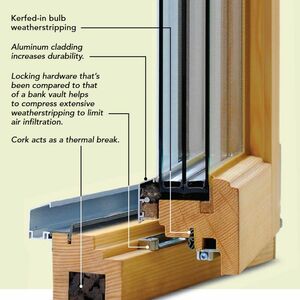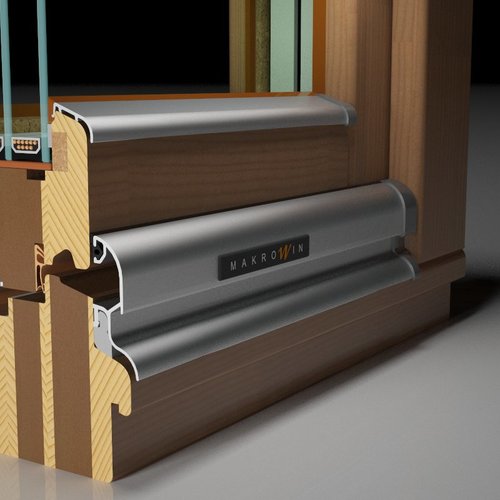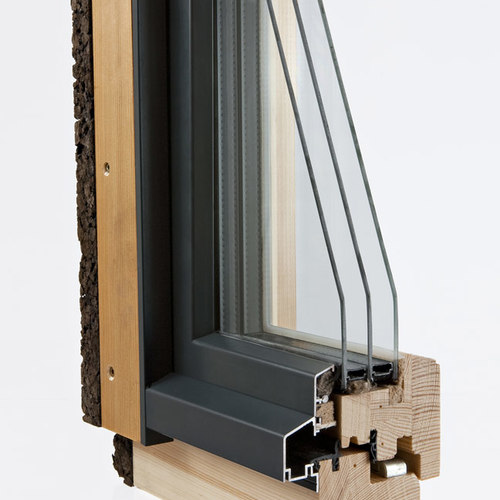
Image Credit: GreenBuildingAdvisor
It should come as no surprise that Europe, home of the Passivhaus standard, produces some outstanding windows. Some builders of high-efficiency houses in North America turn to European window manufacturers for their glazing, even though some U.S. and Canadian producers also offer high-performance products of their own.
Is there a way to compare the performance data on windows from these two sources? That’s what Steve Young, now planning a Passive House in Climate Zone 5, would like to know.
“I have read many blogs and Q&A pages from this web site and I am still somewhat confused about European windows,” Young writes in Q&A post at GreenBuildingAdvisor.
First, he says, there are the different testing standards between North American and European manufacturers, which makes Young wonder how he should view data on U-factors, solar heat gain coefficient (SHGC), and visible transmittance (VT).
“So should I pretty much ignore the U-factors, if I am looking at the ‘best’ glass and frames and compare the SHGC and VT only?” he asks. “The Optiwin figures (SHGC 0.52) seem to beat anything that Thermotech Fiberglass has (SHGC 0.42), or is that somehow measured differently in Europe, too? Transmittance has to be measured the same?”
Young points out that European windows don’t have nailing flanges like North American windows, and that while fiberglass windows are available on this side of the Atlantic, they don’t seem to be available from European makers.
How can the two be compared?
That’s the subject of this month’s Q&A Spotlight.
Testing protocols are different
Don’t ignore published European U-factors, says GBA senior editor Martin Holladay — just keep in mind the fact that you can’t compare them directly…
Weekly Newsletter
Get building science and energy efficiency advice, plus special offers, in your inbox.

This article is only available to GBA Prime Members
Sign up for a free trial and get instant access to this article as well as GBA’s complete library of premium articles and construction details.
Start Free TrialAlready a member? Log in















11 Comments
secret sauce
I can understand the confusion in comparing numbers. There are different methodologies for testing in Europe (ie U value, SHGC, air tightness, water performance etc) but as long as we are aware of them they are still useful. For example, in terms of u values, lower is still better as posted earlier.
Regardless of the product source (Europe or N.America), we as consumers still ought to let some of our common sense work by directly comparing system (not just brochures or performance numbers). Actually handling a sample or corner section says a lot too. Just by product weight, when one product is 2x or 3x heavier you might get an inclination that there is more substance to it….no secret sauce or rocket science required.
To be helpful, below is a small sample set of energy ratings and how they might compare under different methodologies..I hope these display ok otherwise it might not make much sense. Euro U values appear lower but the spread between euro and nfrc values is inconsistent.
NFRC size: 1200mm x 1500mm
Euro Size: 1230mm x 1480mm
Glass: 4 card 180 / 3 / 4 card 180
U imperial / U Metric / U European
0.19 / 1.08 / 1.02
0.2 /1.14 / 1.06
Glass: 4 card 272 / 3 / 4 card 272
U imperial / U Metric / U European
0.17 /0 .97 / 0.94
0.19 /1.08 / 0.99
Glass rating
Thanks for getting at this Scott, I have been wanting a better explanation.
There still seems to be some speculation here in this reporting and not much difinity. It would be great to see a follow up with a good explanation of the differences in testing so we can see the actual dT used for the different test methods, as well as any other differences-glass thickness, iron content.
Window U values are also different depending on the ratio of glass to frame as Mike shows above, and wondering if this has been rectified in the comparison.
Not sure how many out there would be interested to see the numbers, but the generalizations just don't do it for me on this one.
How expensive would it be to take a European window and have it tested in the US to get a actual comparison?
secret sauce
The u values mentioned earlier represent a European system that has been tested by NFRC and also have a European value. There is a minor size difference but more importantly you see that you can’t just use a percentage (ie 10% or 20%) difference. One product tested may be 3% and another 10% spread in values between NFRC and EU methods.
There is a lot to this subject but in general what you find is that the German and many other Europeans offer a range of products but in general their systems look robust and when they are tested they fair well. Tougher regulation in much of Europe have forced industry to produce better products.
Comparisons of Euro vs. North America Window Tests
Mr. Laspa, your second note indicates that the data reported in your first note were for two sets of identical windows tested to the two different standards, is that correct? If so, this is very useful information. Could we get some clarification of some of the nomenclature?
1. The sizes reported by NFRC and Euro were different, even though the windows were the same?
2. What does this mean: "Glass: 4 card 180 / 3 / 4 card 180"
3. You report U values as: "U imperial / U Metric / U European". I thought that U values in "American" units were Btu/(hr ft^2 degF) and the metric SI units were W/(m^2 K). So I assume your U_imperial is this first set of units. What is the difference in U_metric and U_European?
4. Is the first line of your data the Euro ratings and the second line the NFRC results?
Secret Sauce
Lee, to help make things clear I’ll include an attached datasheet. I hope it helps
Comparisons of Euro vs. North America Window Tests
Mr. Laspa, thanks very much for including the table of results. That answers all of my questions. So based on this very limited data set, if we compare U_glass, which is what is usually available from European manufacturers versus NFRC test results for U-value that are for the complete window, then we can say that the Euro test gives an average of 0.70 x the NFRC test result, or 30% lower, with a standard deviation of 5%. Of course, the ratio of these U-values will be variable since the NFRC results depend on the frame while the Euro results do not.
If we are energetic enough to track down the Euro results for both U_window and U_frame, and the Ps/g factor as well as the appropriate areas for each, then we can compute the U-value for the whole window, U_w. If we compare that Euro result with the NFRC results for U-value (whole window), then the Euro results are still lower, but the ratio is about 0.95, or 5% lower, with a standard deviation of 2.4%. This standard deviation seems to be on the same order as the accuracy of the test results. (The accuracy of the test results is just based on the observation that 3 of the 4 measurements for the windows with the Cardinal Glass 272 and 366 give the same U-value result, while one NFRC result shows them differing by 6%. So if we said the measurement uncertainty was on the order of +-3%, then that would be similar to the standard deviation in the ratio of the Euro and NFRC test results.
Deviants
Comparing NFRC test results with European window testing results is a complicated exercise in futility. I've tried it and concluded that the protocols vary enough that you're better off accepting that both protocols have merits, neither is better or worse and that they are simply different.
Trying to generate a 'rule of thumb' or % deviation will get you in trouble. From my investigation, I found that NFRC numbers are linked to very specific glass packages. To ensure accurate comparisons you'd have to be sure that the IGU's you're simulating are exactly the same. Given that European glass manufacturers produce very different glass (more low iron, high SHGC) than what is typically made here in North America, - even by the same companies - you'll be calculating in the 'wishful thinking' territory. To further complicate matters, Passive House window testing protocols deviate slightly from typical European testing protocols. (Who said 'life is easy' and why should the window world be any different?!)
I did produce some graphics (http://slidesha.re/vbkfQE) that illustrate the simulation differences between NFRC and the Passive House Institute (www.passivehouse.com) window testing protocols. The cost difference for the two processes is: approximately $30K for NFRC and approximately $3K for PHI. Not sure what the price is for typical ISO/EN testing process.
The result of this investigation is this: http://www.aphnetwork.org/events-schedule/phi-window-certification-workshop. Hopefully by early next year we'll have a few NFRC simulators trained to provide direct and accurate comparison data and a few more high performance products locally produced and available on the US market. Let's hope so.
"Comparing NFRC test results
"Comparing NFRC test results with European window testing results is a complicated exercise in futility. I've tried it and concluded that the protocols vary enough that you're better off accepting that both protocols have merits, neither is better or worse and that they are simply different. "
I could not agree more!!!
As mentioned (unfortunately not adequately emphasized) in my original post, take the percentages that I listed with a grain of salt - they were in no way intended to be definitive, they were informal and intended to be anecdotal. I did a very poor job of clearly stating that.
Echoing, and quoting, Bronwyn (and also mentioned in my original post), folks who are the real experts in this area emphsize that "Trying to generate a 'rule of thumb' or % deviation will get you in trouble."...Experts in this area have one bit of advice when it comes to trying to do direct comparisons...don't.
Further confusing the issue I think was that the discussion did wander back and forth between glass package and whole window performance and there wasn't always a clear deliniation between them.
Anyway, that the % comments got people talking and investigating further (as seen in the really excellent comments and follow up on this blog) was a real positive, but in retrospect I could have added a much better disclaimer than I did originally.
Regards
'Secret Sauce'
Sorry for the late post, haven't been keeping up w/ GBA lately.
George Bernard Shaw once quipped that, England and America are two nations divided by a common language. When it comes to rating windows, one could say Europe and North America are two continents divided by the same laws of physics.
While G and SHGC are very nearly the same values on both sides of the Atlantic, Uglass and consequently Uwindow are not.
The replies to the original post, particularly those by Greg Smith, identified how the combination of a warmer outdoor temperature in Euro standard and wider airspaces leads to a discrepencies between Uglass in Europe and Uglass in North America.
I am certainly biased, but in my view European window importers who do not also provide NFRC data are practicing Euro-Imperialism. Furthermore, when they only present the more favorable Euro data, without mentioning that it's based on different standard, they confuse consumers who otherwise live in a NFRC world.
Marketplace fairness issues aside, on a more theoretical level, which temperature difference is ultimately better? The honest answer, as Greg Smith suggested, is it depends. The warmer the climate the more the Euro temperature difference makes sense. Besides climate, another consideration is how Uwindow is used. Originally U was used primarily to size heating systems. If that's how you are using Uwindow, and are in a North American heating climate, then use the NFRC data.
If on the other hand you are using Uwindow to help discern annual heating fuel consumption the answer is different. For most Canadians the average outdoor temperature over the heating season is only about -3C (27F), closer to the 0C (32F) outdoor temperature of the Euro standard than the -18C (0F) of the NFRC stnd. So even in North American heating climates, Euro data can make sense to evaluate annual fuel consumption.
HOWEVER, using Uwindow to evaluate heating fuel consumption without considering SHGCwindow is FOOLISH. It's as foolish as picking an energy efficient refrigerator based only on how well it's insulated – without considering compressor efficiency.
The reason to consider SHGCwindow rather than SHGCglass (favoured by the PH standard), is that some window frames (especially Euro window frames) are bulky enough that they disproportionately reduce solar gains, especially in smaller sizes.
The best way to evaluate the net effect of these of gains and losses is with simulation software like RESFEN, HOT2000, PHPP or others. The simulations are worthwhile because often the results are counter-intuitive. When people run PHPP (which uses Euro U's), they usually find a building with super efficient North American windows will have slightly lower fuel bills than the same building with better insulating, but bulkier European PH windows.
In short, if there is a secret sauce, the Europeans aren't using it.
Stephen Thwaites
Thermotech Fiberglass
EN versus NFRC
I've just gone through all of this in detail, as I am building European windows here in the U.S. using Rehau RAU-FIPRO composite profiles (in addition to uPVC European and North American designs).
We have certify all products through the NFRC, and have all of the EN test data on the new system.
As others have mentioned, the biggest difference is do to the boundary conditions. Basically, as the temperature difference across the glass increases, the optimum "air" space between the glass decreases. For example, going from a triple pane with 1/2" argon to 5/8" argon makes very little difference at NFRC boundary conditions, but makes a big improvement at EN boundary conditions. Going bigger yet can drop the NFRC performance.
THE NFRC boundary conditions are better (in northern climates) for calculating peek loads; the EN probably give you better average performance.
The NFRC rating system is not too bad for comparing two similar windows, but it is not the greatest for energy modeling. Why? Because the U-Factor and SHGC coefficient are for a standard sized window, usually pretty large. A good frame will have essentially zero SHGC. Very few frames are as good as triple pane glazing. Even the PHZ frame in our offering has a higher U than the center of glass. These big sizes are chosen to give pretty good numbers. As the windows shrink from this standard size, the U-Factor will increase, and the SHGC will decrease. That is why the EN system uses separate Uframe, Uglass, and glass edge losses.
The European frames are thicker, but you can build much bigger windows with them. The bigger glazing rebates also allow you to maintain optimal "air space" as glass gets thicker.
Glass available in the U.S., like Cardinal LoE 180, performs essentially as well as the European glass when you compare NFRC to NFRC, or EN to EN.
Best regards,
David Paulus
WASCO Windows
Frame Bulk and Glass Area
David Paulus of WASCO Windows is correct in saying that European Tilt & Turn windows can be made with bigger operable sashes to mitigate their bulkier frame.
The question is; How much bigger is needed to maintain a given glass area?
A typical North American Casement has a frame height of about 2 3/4”. A typical European Tilt & Turn has a frame height of about 4 3/4”. In this scenario one 24”x 60” Casement would have the same glass area as one 30”x 60” Tilt & Turn window. In other words in this case the European Tilt & Turn needs to be about 25% bigger to have the same solar gain. Obviously this percentage will vary substantially by size and by supplier.
A Tilt & Turn supplier might say a fairer comparison would be a single 48”x 60” Tilt & Turn vs. a 48”x 60” double casement. In this case the glass areas are closer, but the double casement despite the central mullion still has the larger glass area – by about 3%. A Casement supplier might then point out that invariably some windows will be smaller than this, so that over a whole house the extra glass area would be a higher percentage.
The same types of effects apply when it comes to fixed windows. Most North American firms offer a fixed window with a frame height of about 2”. This is unheard of in Europe where most fixed windows have frame heights of at least 3”. Consider a 48”x 60” fixed window. For this size the bulkier European window needs to be 8% bigger to have the same solar gain. Once again with different supppliers and base sizes this percentage will vary substantially.
A further consideration is that in general North America is sunnier than Central Europe. As an example, compared to a south facing window in Frankfurt, Germany, a south facing window in Urbana, IL receives about 50% more solar energy over the heating season. Even in cloudy Portland, OR a south facing window receives about 20% more solar energy over the heating season than the same window in Frankfurt. This means solar gain characteristics have (like slimmer frames) have a greater potential importance in North America than in Central Europe.
As always, there are also some related secondary considerations. On one hand with effort, a Tilt & Turn frame's jambs and head can be burried in a layer of external insulation further decreasing the heat loss through this component. On the other hand for a given glass area, a slimmer window frame means, that the best insulating area, the wall, is incrementally larger.
With all these varying and conflicting considerations, relying on Uwindow or other summarizing characterisitics to answer to the “which is more efficient?” question is not reliable. A thoughtful answer requires building specific software analysis (like PHPP or HOT2000).
Again, I may be biased, but in my experience, this kind of software analysis will show more often than not that super efficient North American windows will be slightly more energy efficient than better insulating, but bulkier European PH windows.
Stephen Thwaites
Thermotech Fiberglass
Log in or become a member to post a comment.
Sign up Log in